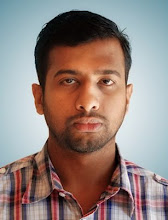DIGITAL COMPOSITING
Robots were familiar to me as stories and pictures in my school days. The replica of human intelligence that became his biggest blooper. The stories instilled amazement in me but I believed that they were figments. I hardly believed that they existed until I saw a movie called Terminator 2: Judgment Day. The film tells a story of a machine, a terminator, who has been sent back from the year 2029 by a race of artificially intelligent computer-controlled machines bent on the extermination of mankind. The Terminator's mission is to kill a woman named Sarah Connor whose future son founds a resistance against the machines. The science fiction builded up my surprise. A couple of years later I got another shock- ‘Jurassic Park’. These movies really confounded me. Obviously the techniques used in Hollywood films were beyond my imagination. Ignorance is bliss- those movies became my agitations and my agitation became my habit.
Ignorance is bliss. It becomes bliss when a person conquers it. Computer-generated visual effects are now used extensively in feature films, commercials, music videos, and multimedia. The backbone of this process, the final and most important step, is known as digital compositing. In digital compositing images from variety of different sources are taken and combined in such a way that they appear to have been shot at the same time under the same lighting conditions with the same camera. Another way to think of compositing would be as the process of combining multiple footage layers or “elements” to make them appear as if they were shot with the same camera, at the same time under the same lighting conditions. All elements married together and “belonging” in the environment. The environment, in compositing terms, is considered the background or “BG Plate” and is typically live action footage. Examples of image elements that can go into a composite are: BG plate (live action photography), blue/green screens, CGI (computer generated imagery) characters and objects, practicals, miniature models, matte paintings, text, etc. Compositing has given a great contribution to the film industry, especially to the Hollywood. Compositing gave birth to some block buster movies like Star Wars, The Jurassic Park, The Matrix trilogy, Hulk, Spiderman etc. Thousands of spectacular movies are credited to this post production technique.
In the modern film industry compositing has almost an equal importance with that of editing. When an editor treats his visuals as one, the compositor treats it as four- the three color channels plus the alpha channel. The alpha channel is a channel which holds the opacity: transparency information of an image. So, this difference in the treatment of a visual helps a compositor to make ordinary men walk over the sea, fly over the clouds or even make them swim without any gears. Digital compositing provides numerous advantages and flexibility to the production pipeline. In the film ‘Gladiator’ the Colosseum were populated with 2,000 extras, who are seen cheering alongside 33,000 computer-generated spectators. Digital Compositors created the CG audience by filming real extras performing a variety of motions and mapping them onto two-dimensional cards that were positioned in each seat.
A different version of compositing can be seen in today’s television programs where an anchor is composited over computer generated imagery, popularly known as BG. The weather reports, news reading, sports etc take advantage of this technique. Live-action shooting for compositing is variously called “blue screen,” “green screen,” “chroma key,” and other names.Indian film industry has also availed compositing techniques to create remarkable hits like Krish and Gajini. Their achievement in the visual effects matches international standards which ultimately opened new vistas. Pioneering a major breakthrough in the area of 3D Animation in Hindi movies, Visual Computing Labs (VCL), a division of Tata Elxsi Limited that offers content creation, animation and special effects services to both Hollywood as well as Bollywood, has successfully composited a 3D Character with live action, for the forthcoming Bollywood feature "Fun2shh". Incidentally, VCL has already achieved the distinction of being the first to use this technique in an Indian movie, when they composited a CG Girl character with live characters in the Tamil movie BOYS, directed by renowned director Shankar. In the movie ‘Rang de basanti’ Aamir Khan and his buddies sprint towards a runway through paddy fields and leap up in the air as a MiG takes off above their heads. The paddy fields and the people are for real, but the runway and the MiG were added at Tata Elxsi’s Visual Computing Labs (VCL) in Mumbai. They have deleted the village and put in an air base instead. The aircraft was created digitally too.
As the entertainment industry is advancing at a higher pace, new and sophisticated tools are fabricated to create more and more spectacles. However, a good artist who has three distinct bodies of knowledge –the art, the tools and the technique, is vital for a high-end digital effects compositing. For long form media such as films, where the goal is to make the work seamless, integrated and “invisible”, compositor plays a crucial role. The compositing techniques and tools are not only limited to use in films, but they can also be applied to video and games production as well.



















![Images by me [May 2007]](http://photos1.blogger.com/x/blogger2/7416/85458861222343/254/z/863964/gse_multipart34055.png)